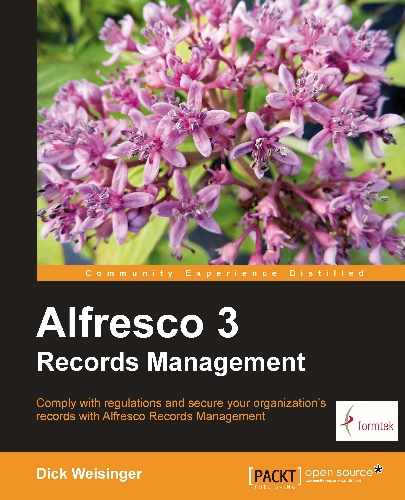- Alfresco 3 Records Management
- Alfresco 3 Records Management
- Credits
- About the Author
- About the Reviewer
- www.PacktPub.com
- Preface
- 1. Records Management
- What is a record?
- What is Records Management?
- Record lifecycles
- Benefits of Records Management
- Records Management is about complying with legal requirements
- Records Management is about ensuring accountability
- Records Management is about preserving assets
- Records Management is about efficiency
- Records Management is about being prepared
- Records Management is about coming to grips with data volumes
- Records Management is about security
- Records Management is about good business
- Summary
- What is a record?
- 2. Getting Started with the Alfresco Records Management Module
- The Alfresco stack
- Alfresco software
- How does it work?
- The Records Management AMP Files
- The Records Management Console dashlet
- The flow of Alfresco webscripts
- The flow of the Records Management webscript dashlet
- The Records Management dashlet files
- The Records Management dashlet files in the MVC Pattern
- The Records Management descriptor file
- The Records Management dashlet controller
- The Records Management dashlet view
- The Records Management dashlet URL
- The Records Management console client-side JavaScript
- Creation of the Records Management site
- Web development within Share
- Summary
- 3. Introduction to the Alfresco Share Records Management Site
- The Share environment
- The Records Management site
- How does it work?
- Share configuration files
- Dashboards
- Creating a new Share theme
- Share site top navigation toolbar
- Summary
- 4. Metadata and the Alfresco Content Model
- 5. Creating the File Plan
- The File Plan — a definition
- Best practice for creating the File Plan
- Creating the File Plan
- File Plan container metadata
- Copy and move of File Plan containers
- How does it work?
- Summary
- 6. Creating Disposition Schedules
- 7. Filing Records
- Filing — more than one way
- Filing an electronic record from Share
- Filing a non-electronic record from Share
- Filing from another Share site
- Filing a record from a CIFS mounted drive
- Filing from an e-mail client with IMAP
- Filing to Alfresco via FTP
- Bulk import
- Filing by scanning
- Other ways to file
- How does it work?
- Summary
- 8. Managing Records
- Records Details
- How does it work?
- The Details page
- The JavaScript controller for the Details page
- The FreeMarker template for the Details page
- The Details page
- Summary
- 9. Following the Lifecycle of a Record
- Undeclared records
- Specifying mandatory metadata
- Declaring the record
- Record review
- Closing a Folder
- Cutoff
- Transfer
- Accession
- Destruction
- Audit log
- Hold or freeze
- The File Plan report
- How does it work?
- Summary
- 10. Searching Records and Running Audits
- 11. Configuring Security and Permissions
- 12. Configuring Records Management Parameters
In this chapter, we will see one of the biggest benefits of using an Electronic Records Management (ERM) system, namely, Search. When using a traditional paper-based records management system, finding records with any criteria other than the filing structure enforced by the File Plan is very difficult and time consuming.
Search is an excellent complement to the capabilities provided by the File Plan. Search improves the accuracy of locating important records and it is a necessary tool for being able to respond to legal and e-Discovery requests in a timely way.
In this chapter, we will now describe:
- How to perform basic and complex searches using the Records Search page
- How to create and use saved searches
- How to audit the actions and events that have occurred in the records system
We've spent much of this book discussing the File Plan. The File Plan is central to many of the concepts of Records Management. It is a well-understood organizational tool for categorizing and filing records, and it assists in locating records and in managing record lifecycles.
But over the last decade, with the wider introduction of Electronic Records Management (ERM) systems, search has become an important complementary tool to the File Plan. With search, the ability to locate records efficiently has improved dramatically. E-Discovery, by its very definition, would not exist today without search.
-
No Comment
